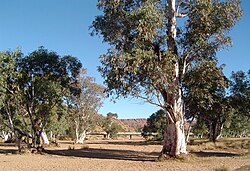This article includes a list of general references, but it lacks sufficient corresponding inline citations. (July 2008) |
| Todd River (Lhere Mparntwe) | |
|---|---|
 The dry riverbed of the Todd River | |
 | |
| Location | |
| Country | Australia |
| Physical characteristics | |
| Source | |
| • location | MacDonnell Ranges |
| Basin size | 445 km2 (172 sq mi) |
The Todd River (Arrernte: Lhere Mparntwe / Lhere Imatukua)[1] is an ephemeral river in the southern Northern Territory, central Australia. The origins of the Todd River are in the MacDonnell Ranges, where it flows past the Telegraph Station, almost through the centre of Alice Springs (Mparntwe), through Heavitree Gap at the southern end of Alice Springs and continuing on for some distance, passing through the western part of the Simpson Desert, as it becomes a tributary of the Hale River, and eventually flowing into Lake Eyre in South Australia.[2]
The indigenous Arrernte people know this river as Lhere Mparntwe (Eastern Arrernte pronunciation: [l̪ərə ᵐbaⁿɖʷə]) where it runs through Alice Springs and Lhere Imatukua (Eastern Arrernte pronunciation: [l̪ərə imatukua]) as a whole.[1] These names were recorded by TGH Strehlow in "Songs of Central Australia".[3]
The Todd is in a very arid part of Australia and has zero to very low flow during 95% of the year.[4] When it does flow, it carries a heavy sediment load picked up from the grazing land around the Bond Springs homestead which lends its waters a milky chocolate colour and renders them completely opaque.
The Todd River's English name, and that of its tributary, the Charles River, were given by surveyor W. W. Mills, after Charles Todd, then South Australian Superintendent of Telegraphs and Postmaster General of South Australia, who was largely responsible for the construction of the Overland Telegraph Line.[5][6]
- ^ a b Cite error: The named reference
:0was invoked but never defined (see the help page). - ^ Todd River - A Rare Occurrence
- ^ Strehlow, Theodor G. (1971). Songs of Central Australia. Sydney: Angus & Robertson. ISBN 978-0-207-94657-8.
- ^ "Todd River". www.bom.gov.au. Australian Bureau of Meteorology. c. 1995. Retrieved 13 January 2015.
- ^ Todd River Northern Territory Government Place Names Register Retrieved 9 June 2020.
- ^ Charles River Northern Territory Government Place Names Register Retrieved 9 June 2020.